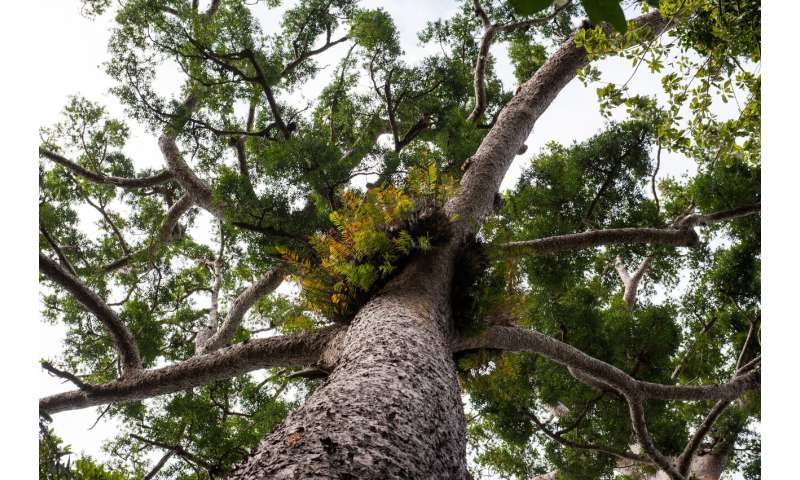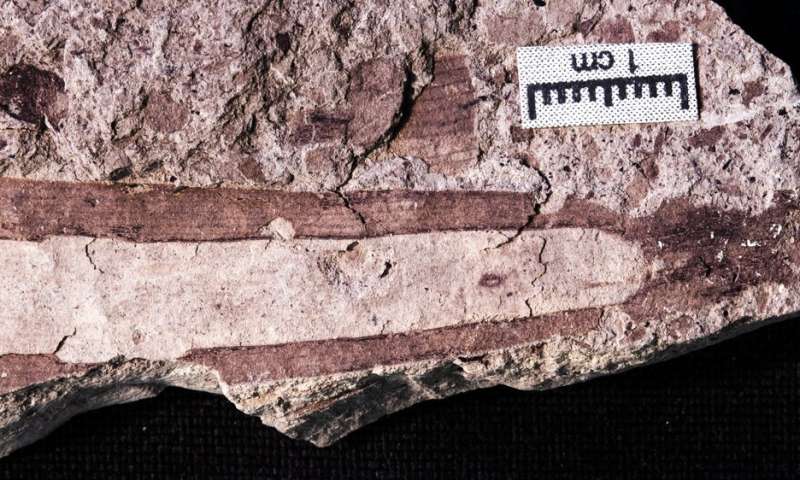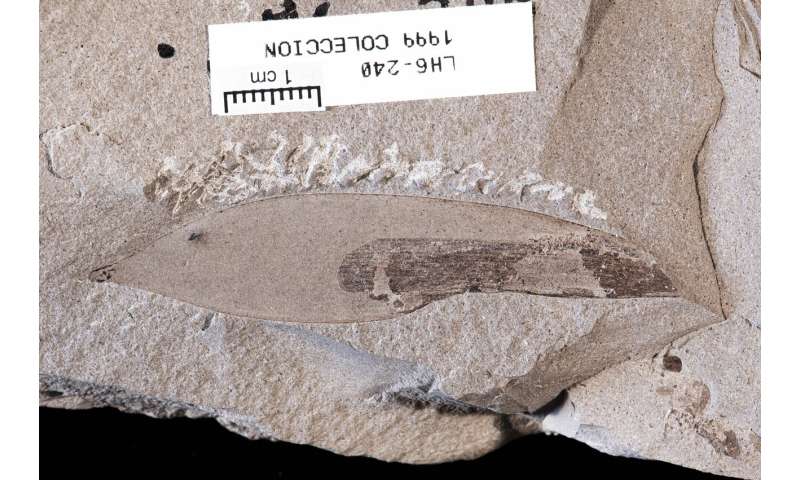by Cleveland Museum of Natural History
NOVEMBER 25, 2020

Agathis microstachya and Agathis robusta growing near Lake Barrine, Australia.
Credit: Cleveland Museum of Natural History
Exquisitely preserved feeding marks on fossil conifer leaves show that the same insect feeding and fungi persisted for millions of years on the same type of plant, from ancient Patagonian rainforests to the modern rainforests of the tropical West Pacific.
Over 50 million years ago, rainforests teeming with life stretched across the ancient supercontinent Gondwana, including what is now South America, Antarctica and Australia. Based on fossil evidence, many plants that now live in places like Australia, New Guinea and Borneo are survivors from the Gondwanan rainforest. Fossil leaves from the Patagonian region of southern Argentina also preserve an astonishing variety of insect-feeding damage traces like those seen in modern rainforests, showing that the Gondwanan forests were also home to diverse plant-feeding insect communities. Did those ancient plant-insect communities survive the breakup of Gondwana and the dramatic range changes of the host plants, and are they still alive today?
An international group of researchers focused on fossils of Agathis, a majestic, tall conifer commonly known as kauri, comparing thousands of modern specimens from Australasia and Southeast Asia to 482 Patagonian fossils ranging in age from 66 to 48 million years, latest Cretaceous to middle Eocene. Their findings were published today (Nov. 25) in Communications Biology.

Exquisitely preserved feeding marks on fossil conifer leaves show that the same insect feeding and fungi persisted for millions of years on the same type of plant, from ancient Patagonian rainforests to the modern rainforests of the tropical West Pacific.
Over 50 million years ago, rainforests teeming with life stretched across the ancient supercontinent Gondwana, including what is now South America, Antarctica and Australia. Based on fossil evidence, many plants that now live in places like Australia, New Guinea and Borneo are survivors from the Gondwanan rainforest. Fossil leaves from the Patagonian region of southern Argentina also preserve an astonishing variety of insect-feeding damage traces like those seen in modern rainforests, showing that the Gondwanan forests were also home to diverse plant-feeding insect communities. Did those ancient plant-insect communities survive the breakup of Gondwana and the dramatic range changes of the host plants, and are they still alive today?
An international group of researchers focused on fossils of Agathis, a majestic, tall conifer commonly known as kauri, comparing thousands of modern specimens from Australasia and Southeast Asia to 482 Patagonian fossils ranging in age from 66 to 48 million years, latest Cretaceous to middle Eocene. Their findings were published today (Nov. 25) in Communications Biology.

Leaf mine on a leaf of cf. Agathis from the latest Cretaceous Lefipán Formation, Chubut, Argentina. Similar blotch mines on Agathis from before and after the Cretaceous-Paleogene extinction (when the non-avian dinosaurs went extinct) represent the first evidence of a probable surviving leaf mine association on the same plant genus during the mass extinction. Credit: Cleveland Museum of Natural History
"We found remarkably similar suites of insect and fungal damage on fossil and living Agathis leaves over a vast span of time and space," said Dr. Michael Donovan, Senior Collections Manager of Paleobotany & Paleoecology at the Cleveland Museum of Natural History and lead author of the paper.
Insects have evolved many different plant-feeding strategies, and hundreds of damage types have been recognized in the fossil record. On both the fossil and modern Agathis leaves, the team found highly specialized leaf mines that insect larvae create as they tunnel through leaves, tumor-like galls, bite marks along leaf edges from hungry insects, the waxy protective armor of scale insects, and rust fungi.
Notably, the researchers found extremely similar elongated, blotchy leaf mines on Agathis at all the fossil sites and on multiple living species of the same conifer.

"We found remarkably similar suites of insect and fungal damage on fossil and living Agathis leaves over a vast span of time and space," said Dr. Michael Donovan, Senior Collections Manager of Paleobotany & Paleoecology at the Cleveland Museum of Natural History and lead author of the paper.
Insects have evolved many different plant-feeding strategies, and hundreds of damage types have been recognized in the fossil record. On both the fossil and modern Agathis leaves, the team found highly specialized leaf mines that insect larvae create as they tunnel through leaves, tumor-like galls, bite marks along leaf edges from hungry insects, the waxy protective armor of scale insects, and rust fungi.
Notably, the researchers found extremely similar elongated, blotchy leaf mines on Agathis at all the fossil sites and on multiple living species of the same conifer.

Leaf mine, a tunnel made by a larval insect, on a leaf of Agathis zamunerae (a conifer in the family Araucariaceae) from Laguna del Hunco, an early Eocene fossil locality in Chubut, Argentina. Similar mines were found on fossil Agathis from the latest Cretaceous to middle Eocene in Patagonia and modern species in Australasia and Southeast Asia.
Credit: Cleveland Museum of Natural History
"While working on a previous study on the recovery of insect feeding after the end-Cretaceous "dinosaur" extinction, I surveyed over 20,000 Patagonian and North American leaf fossils," said Dr. Donovan. "The leaf mines on Agathis are the only evidence I found for any type of leaf mine on the same host plant surviving the dinosaur extinction."
The separation of South America from Antarctica led to cooling and drying in Patagonia, and over millions of years, the high-diversity rainforest, including Agathis, disappeared from Patagonia, replaced by the grasslands and lower-diversity temperate rainforests of today. Agathis requires consistently rainy conditions to survive and must have tracked rainforest habitats throughout its history as the Earth's plates moved, leading to its current distribution in warm, wet areas from New Zealand to Malaysia.
The researchers said that the environmental tracking by Agathis as the southern continents moved into their current positions might have provided stable conditions that led to the establishment of long-term relationships between Agathis and the insects and fungi that depend on it, even as its range has shifted massively. The scientists said it is also possible that unrelated groups of insects fed upon Agathis in similar ways at different points in its history.
"I've walked in mountain rainforests of Australia and Borneo and seen exactly the same feeding patterns on living kauri trees as in 65-million-year-old fossils that we've collected in Argentina," said Dr. Peter Wilf, professor of geosciences at Penn State University and a participant in the study. "It's absolutely stunning, all the more so because these communities and the threatened biodiversity and evolutionary history they represent were never noticed before, and we're documenting them first from fossils."
Explore further Iconic Australasian trees found as fossils in South America
"While working on a previous study on the recovery of insect feeding after the end-Cretaceous "dinosaur" extinction, I surveyed over 20,000 Patagonian and North American leaf fossils," said Dr. Donovan. "The leaf mines on Agathis are the only evidence I found for any type of leaf mine on the same host plant surviving the dinosaur extinction."
The separation of South America from Antarctica led to cooling and drying in Patagonia, and over millions of years, the high-diversity rainforest, including Agathis, disappeared from Patagonia, replaced by the grasslands and lower-diversity temperate rainforests of today. Agathis requires consistently rainy conditions to survive and must have tracked rainforest habitats throughout its history as the Earth's plates moved, leading to its current distribution in warm, wet areas from New Zealand to Malaysia.
The researchers said that the environmental tracking by Agathis as the southern continents moved into their current positions might have provided stable conditions that led to the establishment of long-term relationships between Agathis and the insects and fungi that depend on it, even as its range has shifted massively. The scientists said it is also possible that unrelated groups of insects fed upon Agathis in similar ways at different points in its history.
"I've walked in mountain rainforests of Australia and Borneo and seen exactly the same feeding patterns on living kauri trees as in 65-million-year-old fossils that we've collected in Argentina," said Dr. Peter Wilf, professor of geosciences at Penn State University and a participant in the study. "It's absolutely stunning, all the more so because these communities and the threatened biodiversity and evolutionary history they represent were never noticed before, and we're documenting them first from fossils."
Explore further Iconic Australasian trees found as fossils in South America
More information: Persistent biotic interactions of a Gondwanan conifer from Cretaceous Patagonia to modern Malesia, Communications Biology (2020).
Journal information: Communications Biology
Provided by Cleveland Museum of Natural History
No comments:
Post a Comment